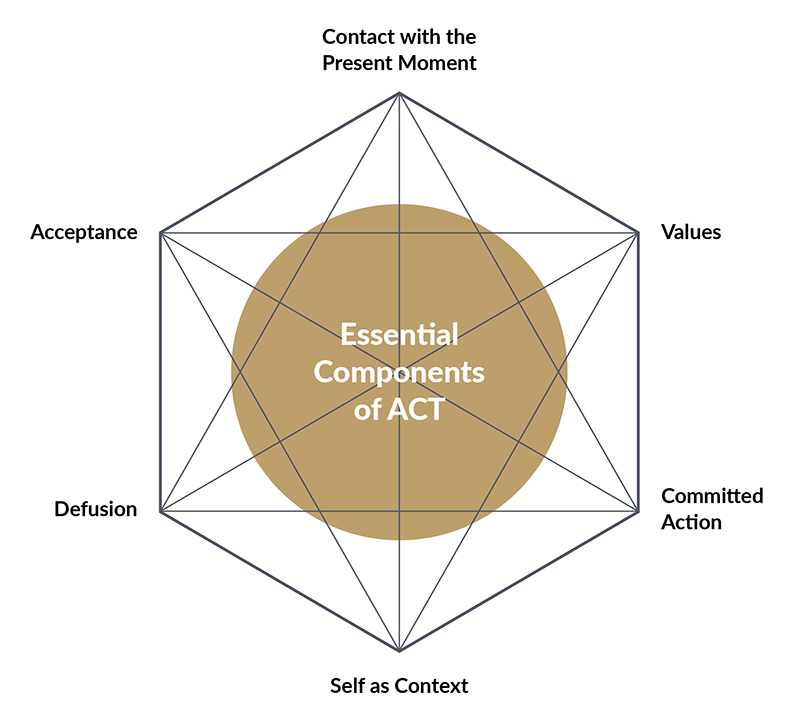What Is ACT? The Hexaflex Model and Principles Explained
 Acceptance and Commitment Therapy (ACT) is a third-wave Cognitive-Behavioral Therapy (CBT) that can be a breath of fresh air for coaches and therapists.
Acceptance and Commitment Therapy (ACT) is a third-wave Cognitive-Behavioral Therapy (CBT) that can be a breath of fresh air for coaches and therapists.
Third-wave CBT therapies incorporate mindfulness as their distinguishing factor.
ACT is a therapy modality that allows therapists to include the client’s values into the clinical or coaching work, ensuring that clients feel connected to and invested in the work.
In a few words, ACT helps clients embrace their demons and follow their hearts (Harris, 2006).
ACT is a behavior-focused treatment, and clients can see a real change in their lived experience in a short amount of time. In this article, we will discuss this in more detail and explain the processes of the hexaflex model so that you can start using ACT principles in your work.
Before you continue reading, we thought you might like to download our three Grief Exercises [PDF] for free. These science-based tools will help you move yourself or others through grief in a compassionate way.
This Article Contains:
ACT Model and Principles: The Hexaflex Explained
ACT uses a unique diagnostic tool called the hexaflex (Bach & Moran, 2008).
The hexaflex is a hexagonally shaped visual aid for classifying and treating client problems holistically. Each of the six domains corresponds to one of the core ACT principles, all of which have various activities and exercises to help the practitioner push their clients along. Using this tool, the therapist or coach can choose a starting point for their therapy intervention.
ACT is all about helping clients cultivate psychological flexibility. The points of the hexaflex represent the six aspects of psychological flexibility.
Psychological flexibility is a set of skills that allow us to be connected to the present moment while acting on longer term values instead of shorter term impulses. It is a person’s ability to change their thinking and behavior when it is not serving them.
To use the hexaflex successfully, the practitioner must be familiar with the principles of ACT.
Present Moment

The purpose of this focus on the present moment is to restore a sense of control lost in many clients seeking therapy or coaching.
ACT practitioners believe you cannot control anything except your behavior. We consider thoughts and emotions transient events that arise and wash over us like waves with no necessary action. We can’t control how we think or feel, but we can control how we act.
There is no time to control our behavior but the present moment, although our minds often take us to the past and future to ruminate on mistakes or make plans.
Past and future thoughts have a purpose. We can learn from our mistakes, predict challenges, remember happy times, and look forward to exciting things. Problems arise when the client cannot make contact with the present moment (i.e., choose to be present).
Without present moment awareness, ruminating and planning can become the default mode of thinking, causing real problems for the individual. ACT therapists help clients build their presence through a series of mindfulness exercises. Clients then learn to shift from planning and dwelling to focusing on what they can control.
Informal mindfulness practices are small ways that clients can start to build their present moment awareness. A few of our informal mindfulness worksheets such as Right Here, Right Now, and Nature Play can help clients build this aspect of psychological flexibility.
Acceptance
All of us have parts of ourselves that are less desirable or attractive, pieces of us that sometimes feel like a burden.
If only we could say goodbye to these unwanted pieces and start anew, right? This question represents an exaggerated but common mindset focused on curing or severing rather than accepting who you are and what you do.
As Harris (2006) suggested, ACT helps clients embrace their demons and follow their hearts. Acceptance is the aspect of the hexaflex that corresponds to the first part of that phrase: embracing your demons. In ACT, ‘demons’ are a metaphor for any unwanted private experience.
We all have a limited supply of energy. If we are continually struggling to suppress these dark parts, how can we focus on making changes in the present moment? By trying to control these problematic thoughts and feelings, the client gives up control of their behavior.
The poet Rumi makes a case for acceptance most eloquently in his poem The Guest House:
The Guest House
This being human is a guest house.
Every morning a new arrival.
A joy, a depression, a meanness,
some momentary awareness comes
as an unexpected visitor.
Welcome and entertain them all!
Even if they’re a crowd of sorrows,
who violently sweep your house
empty of its furniture,
still, treat each guest honorably.
He may be clearing you out
for some new delight.
The dark thought, the shame, the malice,
meet them at the door laughing,
and invite them in.
Be grateful for whoever comes,
because each has been sent
as a guide from beyond.
Jalāl, Barks, & Moyne, 2004
Therapists and ACT coaches help their clients welcome all of their “guests,” giving them the skills to accept these experiences and commit to act by their values.
Values

Once you’ve helped your client identify a value, they have an indicator to follow on their journey.
There are always obstacles, but having a compass means that you can reset or change direction when you’ve lost your way.
Values differ from goals, although the two are easily confused. The difference is that goals are finite; they end, and the person moves on to the next one. Values are ongoing and infinite. They are chosen qualities of action that can never be accomplished but can be acted on moment by moment (Harris, 2019).
For example, finding time for a vacation with your family is a goal, while a love of family is a value. Taking a weekly bike ride is a goal, while caring for your health and wellbeing is a value. Your values tell you what direction to go, while your goals are the steps that help you get closer to living a meaningful life.
Cognitive Defusion

We use language both externally to communicate and internally to think. ACT clinicians understand and help alter how clients use language internally.
As children, many of us learn to be polite when speaking to others. Kindness can be easy when talking to someone else, since you don’t want to hurt that person’s feelings or damage a connection. However, we often pay little attention to the way we talk to ourselves. Clients often suffer from a lack of self-kindness, calling themselves names they would never dare unleash into the world.
When we use a negative label for ourselves repeatedly, such as stupid, we can sometimes become “fused” with that language, identifying ourselves with it. Cognitive defusion loosens the grip that the client has on these negative self-labels. Cognitive defusion helps clients see their thoughts as thoughts, rather than literally accurate interpretations of reality.
Self-as-Context

This aspect has close ties to mindfulness, which we will discuss below. Remember, ACT is based on language, and a big part of the work is to help the client let go of their grip on their negative self-labels. Self-as-context gets at the tendency for clients to over-identify with their thoughts and experiences.
We tend to identify ourselves by what we do. We can see this phenomenon in how we describe ourselves to new people. We start with our names, and then what’s next? Our profession. I’m Joshua, and I’m a writer. There is nothing wrong with this in principle, but it illustrates the brain’s tendency to identify itself with experience.
ACT helps the client move from thinking of themselves based on the content of their thoughts. For example, someone who has gone through a series of bad breakups and failed relationships may think of themselves as unlovable. They become fused with the thought, “I’m unlovable.”
The therapist helps the client shift their thinking about this by helping them to see that they are not the content of their thoughts but the context in which they occur. In short, they learn to say: “I’m having the thought that I’m unlovable.” This practice can create a substantial amount of distance from painful thoughts.
To describe what self-as-context means, we can think of the mind as a canvas on which we paint thoughts. Or we can think of our mind as the sky and our thoughts and feelings as the weather. The sky is simply the place where weather occurs. It is not the storm, but the context where the storm occurs.
Embodying this mindset with thoughts and feelings allows the person to detach from the inevitable highs and lows of human existence. One powerful technique for teaching this to clients is the Meditation for Radical Acceptance.
The ACT hexaflex – Nesh Nikolic
Committed Action
Committed action is the most visible behavior change aspect of ACT since it occurs in the external world, in the here and now. Once clients have identified their values, they commit to taking actions that will allow them to live in alignment with those values.
Committed action occurs at every point in ACT treatment, as clients can consider coming to therapy or coaching as one aspect of their committed action.
Returning to the mantra, embrace your demons, follow your heart, committed action encapsulates the second half of this statement. Clients in ACT commit first to getting to know their hearts by identifying values and then following their hearts by committing to act with their values at the forefront of their minds.
The ACT therapist gradually encourages patterns of effective behavior that are linked to the client’s values. This is often spoken about as the last step in the process, since it takes time to problem solve and understand what behaviors and internal processes need attention.
Remember the prior distinction about values and goals? This is the part of the process where goals come into play. The therapist helps identify goals that will help the client get where they need to go.
This collaborative goal setting makes therapy function like a creative workshop. The two parties set goals for the client, who tries them out in real life, then reports on the progress in the next session. Together they tweak and alter the goal, and then the client tries the experiment again – a process similar to CBT. The difference is that ACT prioritizes the client’s underlying values as the structure for every intervention.
Just like in other interventions, ACT therapists and coaches help their clients set realistic, manageable goals. If you are looking for an approach to take for this purpose, check out our SMART+ Goals Worksheet.
A Look Into Mindfulness in ACT

It is integrated throughout the process, coming through most clearly in the present moment, cognitive defusion, and self-as-context aspects of the treatment.
Mindfulness practitioners learn to respect the transient nature of thoughts and notice their comings and goings peacefully and dispassionately.
The most prominent exercise in ACT mindfulness is the Leaves on a Stream meditation described above.
It falls into a broader category of “thought watching” mindfulness exercises, which encourage mindfulness practitioners to observe their thoughts and do nothing to change, alter, or hurry them up.
Many variations of this popular meditation exercise can be found throughout the web, including on YouTube.
Additionally, ACT therapists looking to share this meditation with their clients can do so via the blended care platform Quenza, which features a 10-minute audio version of the meditation in its growing library of psychoeducational activities.
Overall, ACT blends mindfulness throughout the process and provides many opportunities for therapists and clients to hone their skills in accepting the meanderings of their minds. It is an intuitively mindfulness-based therapy and can be a good fit for therapists and coaches interested in integrating the concept into their work.
PositivePsychology.com’s Helpful Resources
Besides the tools and worksheets mentioned above, there are many resources on our site for those looking to learn about ACT. For more information about ACT, check out the posts listed below.
How Does Acceptance And Commitment Therapy (ACT) Work? describes the mechanisms that make ACT an effective therapy intervention.
Our article on the Theory Behind ACT Therapy plays out the theory that underlies ACT: Relational Frame Theory. This theory explains the ACT focus on language quite clearly.
Lastly, this article provides more ACT Worksheets and ways to apply the theory in your work.
There are also many tools in the Positive Psychology Toolkit© that are very relevant to ACT work. To access over 400 worksheets, interventions and exercises, you can gain access to these for a small annual subscription.
If you are a coach who is interested in incorporating ACT values work into your practice, consider taking our Meaning & Valued Living Coaching Skills Masterclass©. Take this class to learn all about values, including how they affect our behavior and how to help your clients identify their values in your clinical or coaching work.
If you’re looking for more science-based ways to help others move through grief in a compassionate way, this collection contains 17 validated grief and bereavement exercises. Use them to help others find balance as they attempt to make sense of a life that has been irrevocably changed.
A Take-Home Message
ACT is a dynamic, exciting, and evidence-supported treatment for all kinds of client concerns.
The hexaflex model is an intuitive and attractive diagnostic tool that practitioners can use to conceptualize the client and plan their interventions.
An in-depth education in ACT is necessary to use this tool in practice, so if you are interested, do your research by reading therapy books or attending a seminar.
We hope you enjoyed reading this article. Don’t forget to download our three Grief Exercises [PDF] for free.
- Bach, P. A., & Moran, D. J. (2008). ACT in practice: Case conceptualization in acceptance and commitment therapy. New Harbinger Publications.
- Jalāl, D. R., Barks, C., & Moyne, J. (2004). Rumi: Selected poems. Penguin.
- Harris, R. (2006). Embracing your demons: An overview of acceptance and commitment therapy. Psychotherapy in Australia, 12, 70.
- Harris, R. (2019). ACT made simple: An easy-to-read primer on acceptance and commitment therapy (2nd ed.). New Harbinger Publications.
Let us know your thoughts
Read other articles by their category
- Body & Brain (49)
- Coaching & Application (57)
- Compassion (26)
- Counseling (51)
- Emotional Intelligence (24)
- Gratitude (18)
- Grief & Bereavement (21)
- Happiness & SWB (40)
- Meaning & Values (26)
- Meditation (20)
- Mindfulness (45)
- Motivation & Goals (45)
- Optimism & Mindset (34)
- Positive CBT (28)
- Positive Communication (20)
- Positive Education (47)
- Positive Emotions (32)
- Positive Leadership (18)
- Positive Parenting (4)
- Positive Psychology (33)
- Positive Workplace (37)
- Productivity (16)
- Relationships (46)
- Resilience & Coping (36)
- Self Awareness (21)
- Self Esteem (37)
- Strengths & Virtues (31)
- Stress & Burnout Prevention (34)
- Theory & Books (46)
- Therapy Exercises (37)
- Types of Therapy (64)






What our readers think
Good morning, Josh! Great article. One slight misconception I noticed with the Self-As-Context portion. From what I’ve read of Harris and Hayes, our “mind as the sky” isn’t exactly true in this sense as it would still be a part of the weather. This is reinforcing the idea that we are our mind. Harris mentions the “observing self” as a presence that notices (the sky) the weather (thoughts & feelings) and that there is no mind in the sky, just observation. Just thought I’d add this in there as a relatively new ACT practitioner myself. Cheers!